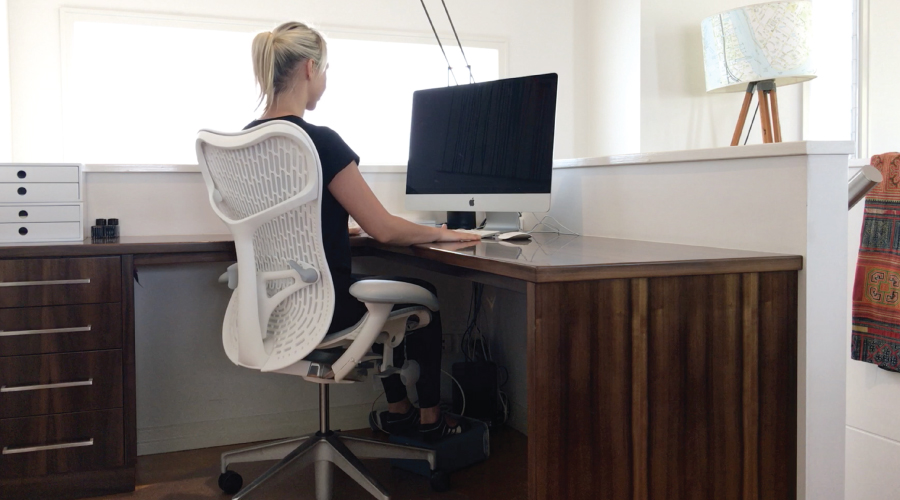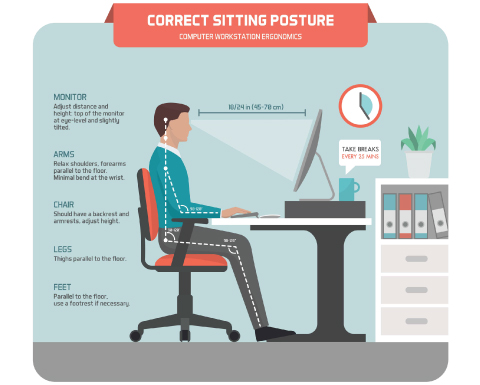It is very common to find people with back and neck problems that are related to their work setting and posture. As physiotherapists, we seek to understand the underlying factors that are responsible for each patient’s ailment. For this reason, we always ask our clients: “What makes the pain worse?” The most common answer we hear is “When I sit at my desk at work”.
Obviously, avoiding sitting at a desk isn’t usually a viable option, however, we can teach you some strategies for working at a desk that will minimise the likeliness of further injury or pain. It may sound strange that just sitting can cause injury, but that’s exactly what can result from poor static posture when sitting at the desk!
There are many reasons for this: Firstly, the human body is not designed to be seated in a chair for 8 hours a day. Stress, poor workstation ergonomics, and bad posture are the main cause of this sort of injury or pain. To remedy these, it is important to position your arms, legs and spine in the appropriate alignment, to distribute the appropriate load on your joints and muscles. Doing so avoids excessive overactivity or overstrain.
Here are 5 tips for a good posture in order to prevent ergonomic injuries:
1. Find your natural posture
- Move your chair away from your desk and sit down comfortably. For most people, it would look a lot like sitting in a car. Your feet are on the floor in front of you; your hands are in your lap, and your shoulders relax as you lean back just a bit.
- This is called your “natural posture.” In it, your vertebrae are stacked, your entire back moves as you breathe, and your pelvis is positioned so that your spine is stacked properly.
- Memorise this natural posture.
2. Keyboard and mouse placement
- Building around the natural posture, the keyboard and mouse should be positioned in a way that keeps your elbows to your sides, and your arms at or below a 90-degree angle. This way, the muscle load is reduced and you’re not straining.
- Position your keyboard 1 to 2 inches above your thighs. For most people, that probably means employing a pull-out keyboard tray. Alternatively, you can lower your desk, but the keyboard tray is a preferred method. Here’s why…
- Tilt. The keyboard should ideally be positioned with a negative tilt — down and away from you so that your arms and hand follow the downward slope of your thighs. That being said, you should never use the kickstand that is incorporated underneath most keyboards.
- Position. Ideally, your keyboard and mouse should be shoulder-distance apart and as level as possible.
3. Position your screen(s)
- Distance. If your screen is too far away, you’ll start doing something called ‘turtling’, or craning your neck, and you’ll find yourself extending your neck to see it.
- To find the right screen position, sit back and extend your arm. The tips of your middle finger should land on your screen. That’s the spot.
- If you have two monitors, set them up side by side (no gap), and place the secondary monitor off-centre. Those who use both monitors equally should centre them both. Now, sit back and extend your arm and pan in an arch. As you pan your arm, your fingertip should almost always touch the monitors. Use the same logic when placing other items, like a document holder or a phone.
- Height. To adjust the height: close your eyes. When you open them, your eyes should land on the address bar. If not, lower or raise the monitors using the built-in option, with risers, or with other items (as long as the monitor is safe and stable).
4. Adjust your chair
Your chair is your best ergonomic friend. It supports your back, bottom, and posture. Here are some things to look for in a good chair:
- Shape. Think back to your natural posture. With your tailbone sticking out just a bit, and your vertebrae in their slight curve, the lumbar portion of your spine points in toward your belly. To help you sustain this posture, find a chair that offers good lumbar support.
- Length. When you sit down, there should be a little space between the edge of the chair and the back of your knees, about the size of your fist. Depending on the chair, you might be able to adjust the seat depth accordingly.
- Height. When you sit, your feet should be on the floor (not dangling) in front of you, and your thighs should be slightly below your hips. Shorter people may need to use a footrest, while extra-tall people may need to adjust the height of the desk.
- If you ever find yourself tucking your feet behind you, sitting on one leg, or in another irregular position, your chair needs to be adjusted.
5. Move every hour (minimum)
- Take a break at least once an hour to walk around the office or stretch. If it helps, set an hourly alarm as a reminder.
- No matter how ergonomic your workstation is, stretching your body is the only thing that can combat the health issues that arise from prolonged sitting.
If you have any questions or concerns about any pain or discomfort you are experiencing, do not hesitate and consult one of our physiotherapists. With Pilates, we can improve the endurance and strength of the postural muscles, so that sitting in the appropriate posture is eventually something that comes naturally.
We have also developed an online 4-week Low Back Pain Pilates program. Take your Physiotherapist with you!
_ _ _
Follow us on Facebook, Instagram and Twitter for a daily dose of Pilates and Wellbeing.



